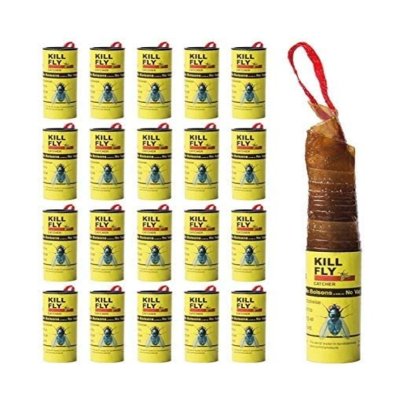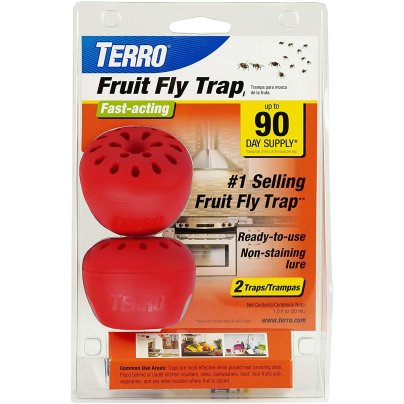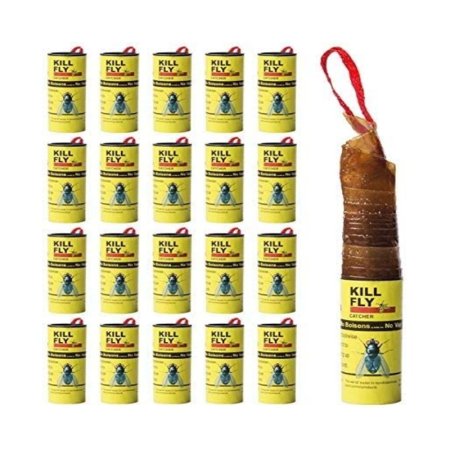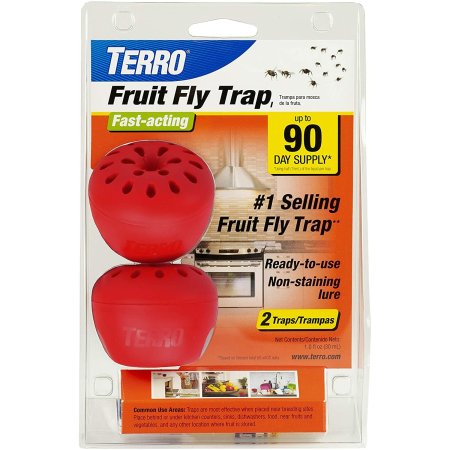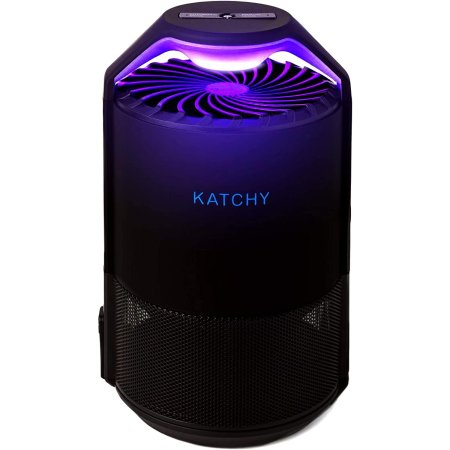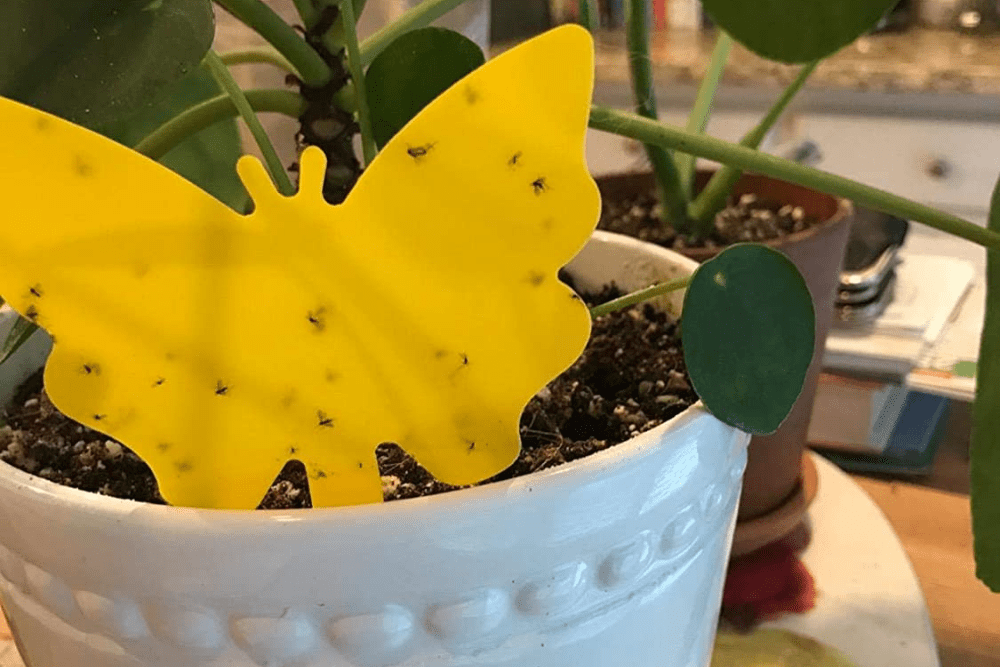
We may earn revenue from the products available on this page and participate in affiliate programs. Learn More ›
Fruit flies are small, irritating insects that are attracted to fruits, as indicated by their name, but also vegetables, meat, dairy, grains, garbage, drains, and any other items or locations that can provide a source of food or a dark, damp location to breed. Fruit fly traps typically use a liquid bait or a light to lure the insects to the trap where they are caught and eliminated through the use of adhesive pads, electric shocks, or physical constructions that they cannot escape.
The best fruit fly trap for your situation will typically depend on the severity of your infestation and the problem locations around your home. Choose a trap that can be easily set up where you need it and that will be effective in treating the scope of your fruit fly problem. One sticky pad won’t help much if there is a literal swarm of flies in your kitchen, but a high-tech electronic trap may be too expensive if you are regularly seeing only one or two fruit flies. Take a look at the top-quality products below to find out more about the best fruit fly traps available.
- BEST OVERALL: Dwcom 20 Pack Sticky Fly Ribbon Catcher
- RUNNER UP: TERRO 2-Pack Fruit Fly Trap
- BEST UPGRADE: KATCHY Auto Sensor Indoor Insect and Flying Bugs Trap
- BEST FOR HOUSEPLANTS: Garsum Sticky Trap
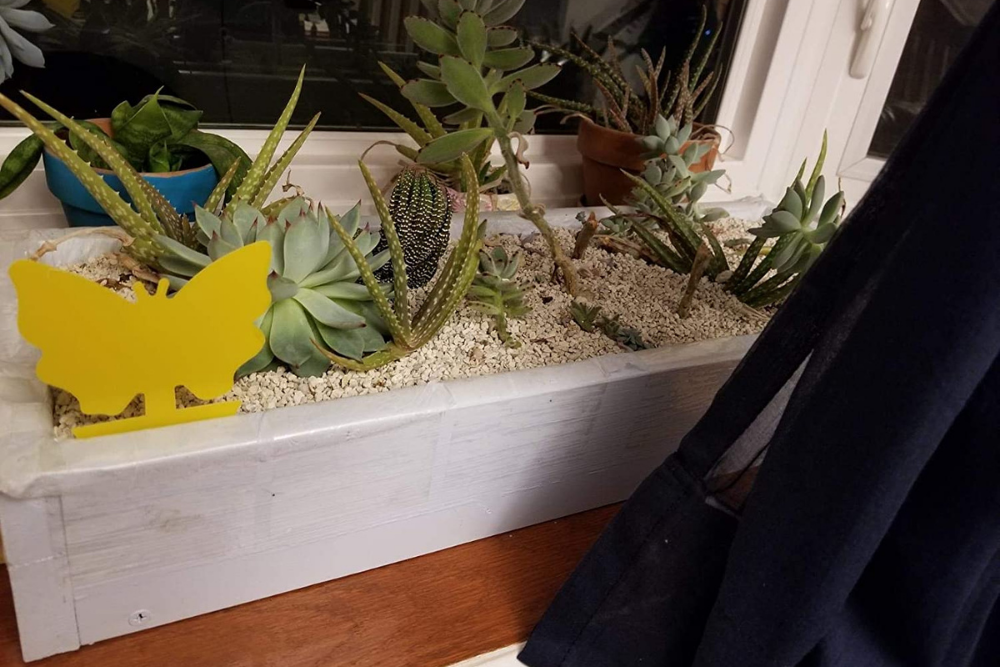
What to Consider When Choosing the Best Fruit Fly Trap
Don’t go shopping before you know which features are most important in a fruit fly trap to avoid choosing a product that may work great for roaches or spiders but does nothing to help with fruit flies.
Type and Ingredients
Fruit fly traps can be split into four basic categories that include sticky traps, physical traps, electronic traps, and natural traps.
- Sticky fruit fly traps use an attractive bait to lure the fruit flies to the surface of the trap. Once they land, they are stuck to an adhesive that typically coats the entire trap. These traps usually use a combination of waterproof paper and glue.
- Physical fruit fly traps may resemble fruit or other objects so that you can place them near problem locations without drawing attention from your guests. The trap will usually contain a liquid bait that attracts the fruit flies through narrow channels. Once inside the trap, the fruit flies cannot escape to eat or reproduce.
- Electronic fruit fly traps have a component that is powered by electricity. This can be a set of lights that are used in place of baits for attracting fruit flies, or it can be a zapper that both attracts and kills the insects. Electronic traps are reusable, and they may be effective against other pests, like mosquitoes and flies, though the initial cost is higher, and with some products, you may still need to replace integrated sticky traps or baits.
- Natural fruit fly traps use all-natural products to effectively handle your fruit fly infestation so that you won’t have to worry about dangerous toxins or chemicals being openly available to kids and pets.
Disposable vs. Reusable
When you are looking for a solution to your fruit fly problem, you will need to decide between a disposable product, like sticky traps, or a reusable option, like an electronic trap.
- Disposable fruit fly traps are inexpensive and usually very easy to use. Sticky traps and some physical traps fall into this category, allowing you to just toss a trap when it is full of dead insects or when the bait is empty. If a disposable trap appeals to you, consider investing in natural traps that won’t harm the environment and will break down quickly.
- Reusable fruit fly traps can include electronic, physical, natural, and even some sticky traps that are equipped with refillable cartridges or pads. These traps reduce your waste potential while dealing with an infestation, and while they have a higher initial cost, this style of trap is less expensive over time.
Location/Placement
Determining where to place your fruit fly traps can also help you decide what type of trap you want to use. Fruit flies can quickly invade your home and take over multiple locations, turning them into breeding areas. These locations are typically dark and damp with available food sources. This can include behind appliances, in drains, bathrooms, garbage, compost, recycling, and even your pantry. To effectively deal with your infestation problem, you should note the locations where you have seen the highest frequency of fruit flies and treat these areas with appropriate fruit fly traps.
Application
Fruit fly traps can come with a variety of application methods, including stakes, hanging traps, fake-item traps, and ground traps.
- Stakes can be placed into the soil in your garden or houseplants where the top portion of the stake sticks out to attract and capture fruit flies. These traps are most often natural sticky traps but can also be reusable physical traps.
- Hanging traps are regularly used in busy kitchens so that you won’t have to take up counter or floor space. Just hang the trap and unwind the sticky adhesive, but make sure you place it where you won’t walk into it. Some electronic traps are also hung up, though these will require a sturdy hook in order to support their weight.
- Fake-item traps are designed to look like common items around your home, giving you the ability to treat your infestation without using unsightly traps that call attention to the problem. Electronic and physical traps can often fall into this application category.
- Ground traps can be placed on the ground or on any flat surface near the infested area. Some of these traps may have a wall adhesive that will let you stick them to a vertical surface. This category of application is seen with sticky, physical, natural, and electronic trap types.
Versatility
When you are looking for a trap to help you solve your fruit fly problem, you may also need to deal with other pesky insects, like flies, mosquitoes, or moths. The versatility of a fruit fly trap refers to its ability to effectively treat other insects as well as fruit flies. If you plan to use these traps for more than one type of infestation, then you need to check the manufacturer’s recommendation to ensure that the trap has the capability to handle your range of pests.
For instance, a physical trap designed to contain a fruit fly will not likely work with a regular housefly because the size difference between the two insects is too great. However, a hanging sticky trap may have a strong enough adhesive to capture fruit flies, houseflies, and even horse flies.
Our Top Picks
The recommendations for the best fruit fly traps below were chosen based on quality, price, and some of the major feature considerations mentioned above so that you can find the right product to solve your fruit fly problem.
Best Overall
Dwcom 20 Pack Fruit Fly Traps
Sticky traps are an excellent way to lure and trap fruit flies because they typically have a bait incorporated into the adhesive, and sticky traps like these can remain effective until the trap is completely full, so you won’t have to continually replace them. The traps should be attached to a wall, ceiling, or any other surface that allows them to hang freely without obstructing your movement in and through the area.
This 20-pack of sticky traps can last you all year long, or it can be used to cover a busy industrial kitchen without impeding the movement of the line cooks. Each trap winds out from the tube, revealing a long tape with double-sided adhesive and a red ribbon that makes it easier to hang. The adhesive is odorless and nontoxic, but you should still keep it away from your kids and pets because it can easily stick to clothing, skin, hair, and fur.
Runner Up
TERRO 2-Pack Fruit Fly Trap
End your fruit fly infestation without using insecticides or unappealing industrial traps that can make your home feel ugly and unclean. Each TERRO trap looks like an apple, so you can leave it on the counter or even put it right into the fruit bowl to treat your fruit fly problem. The trap comes with a bottle of liquid bait that draws fruit flies down into the funnel-shaped holes from which they are unable to escape.
This physical trap doesn’t use any adhesives, and the bait is a nontoxic, food-based formula, making it kid- and pet-safe. The trap remains effective for as long as the bait lasts. This can vary depending on the severity of the infestation, but typically the trap can last for up to 45 days when it has been filled with liquid bait. This product comes with two traps, with enough liquid bait for both traps to remain active for up to 45 days, or to refill one trap in order to last 90 days.
Best Upgrade
KATCHY Automatic Indoor Insect and Flying Bugs Trap
This KATCHY electronic fruit fly trap also fits into the sticky trap category, as it uses disposable adhesive glue boards to trap and kill insects. When a glue board fills up with fruit flies, mosquitoes, gnats, moths, or other small flying insects, it can be replaced with a new glue board, so you can reuse the fruit fly trap as long as the UV light and fan have power.
This trap isn’t just effective at catching fruit flies; it also has a sleek look that may even contribute to the aesthetic appeal of your home. The UV light draws fruit flies and other flying insects into the trap, where a fan pushes the insects out of the air and down onto the adhesive boards. In automatic mode, this trap will only turn on when the lights are off, while manual mode will allow you to turn on the UV light and fan whenever you want, though this trap works best in completely dark environments.
Best for Houseplants
Garsum Sticky Trap
You won’t have to worry about your kids or pets with these natural, nontoxic fruit fly traps, and they are designed to be safe for the environment, breaking down easily after disposal. This is because they are made with a simple combination of waterproof paper and strong adhesive glue. The stakes are UV-resistant and waterproof, making them an excellent option for your garden or houseplants.
This sticky trap has a bright yellow color that is attractive to fruit flies, whiteflies, mosquitoes, fungus gnats, and other small flying insects due to their phototropic nature. The package contains 12 sticky fruit fly stakes in the shape of butterflies and flowers that have adhesive on both sides. This product also comes with a small digging tool to help you place the stake in the soil.
FAQs About Fruit Fly Traps
Below are helpful answers to some of the most common questions about fruit fly traps.
Q. Why do I suddenly have fruit flies in my house?
Due to the small size of fruit flies, they often go unnoticed when you bring produce home from the store. They also enjoy invading fermented items, like beer and wine. Once inside your home, they can breed and develop in many different areas, though they are particularly drawn to drains; garbage; dirty cleaning supplies; and ripe, rotting, or decaying food products.
Q. What are fruit flies attracted to the most?
Fruit flies are attracted to many different items, including drains, garbage disposals, empty bottles, cans, garbage bags, fruits, vegetables, meat, dairy, mops, and cleaning rags.
Q. How long do fruit flies live indoors?
Fruit flies are capable of living for about 30 days in total, whether they are inside or outside. This is the total extent of their life cycle. However, like houseflies, fruit flies will reproduce regularly as long as they are able, which can cause repeated infestations to erupt.
Q. How long does a fruit fly infestation last?
A fruit fly can live up to four weeks on average, eating and reproducing regularly. With this in mind, a fruit fly infestation, like an ant infestation, can last indefinitely as long as ample food and sustainable living conditions are available. If the infestation is treated, you will need to determine several factors before you can even approximate how long the infestation will last. These factors include the type of fruit fly trap, the individual product, the frequency of reapplication, and the initial size of the infestation when the treatment was first applied.
